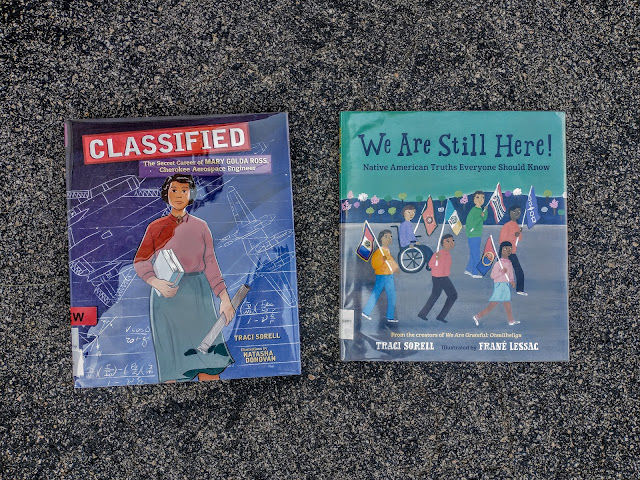Classified: The Secret Career of Mary Golda Ross, Cherokee Aerospace Engineer by Traci Sorell, illustrated by Natasha Donovan.
This is a picture book biography of Mary Golda Ross, who grew up with a strong connection to her Cherokee tribe. As a woman in the 1920's who lived until 2008, her love of math and eventually engineering was uncommon, and she helped blaze a trail for other women and Native Americans.
From the first page, Classified focuses in on four Cherokee values: gaining skills in all areas of life, working cooperatively with others, remaining humble when others recognize your talents, and helping ensure equal education and opportunity for all. I love how the material in the back of the book shows the syllabary, transliteration, pronunciation and English translation of each of these values. In my review here I thought of summarizing the four values, using one word each, but that doesn't really capture what the actual, translated values are. It feels more true to share the direct translation.
Sprinkled with interesting truths about Mary Golda Ross, this biography tells us some of the work that Mary accomplished -- but much of it is still "classified." This made it a little bit difficult for me to remember the book, when I read it among a stack of contenders, and after it had been a little while between readings. What was it she did, again? There is no "one thing" that the book gives her complete credit for. However, this is the big truth -- our accomplishments are cooperative, and Mary Golda Ross apparently understood that well. Upon re-reading the book, I realized it's not the sort of picture book biography that is meant to tell you about one person so much as it is meant to teach you, through one woman's example, these four Cherokee values that she lived by.On my first read? Meh. On my reread? I like it a lot!
The illustrations are well done, and add to the understanding you get from the text. Simple, but not oversimplified, colorful yet still realistic, the art isn't showy, but it is solidly helpful. The backmatter of the book includes a timeline, source notes, bibliography, author's note, and the aforementioned four Cherokee values.
This book was shortlisted for the Cybils Award in the Middle Grade Nonfiction (ages 8-12) category, and I think ages 8 and up is about right for it. I would recommend it to kids parents and teachers who are interested in learning about other cultures and the core values that drive us! Bonus, you will also learn about women in STEM.
We Are Still Here: Native American Truths Everyone Should Know by Traci Sorell, illustrated by Frané Lessac
Another Cybils nominee in the elementary nonfiction category, We Are Still Here reminds me of a young adult graphic novel I read for the Cybils called This Place: 150 Years Retold. This Place won the Cybils award (for Young Adult Graphic Novel) back in 2019. It was so good. I can't believe I didn't review it here! But I helped to write the review of it posted here. Anyway, We Are Still Here gives readers a lot to unpack, and I was grateful for the context that I had from previously reading This Place.

Hand-painted art sets the scene for each "presentation" and features a lot people -- presidents of the United States, children at school, and people on the street just to name a few.
Backmatter is robust in this book, and includes more information on each of the twelve topics, a timeline from the 1870s to the 2007, a glossary, sources, an authors note. While I feel like this book packs a lot of information in, it also gives readers resources for further learning so that they can delve deeper into each of these topics.
I really appreciate that repeating refrain which titles the book: We are still here! The more I have learned and the older I've become, the more I realize the truth of this and the obstacles that indigenous people have faced. I still have a lot to learn. When we moved to Connecticut, I enjoyed learning that "The Last of the Mohicans" -- a movie/book I've never watched/read -- was wrong. The Mohegan tribe is still here!
I recommend this book for older elementary school kids and as a great resource to older students and adults. I have to agree with the books subtitle, it contains history that everyone should know.



Both of these books sound really interesting and like they'd be full of a lot good information that I should know. I'm especially curious about the second book. Thanks for putting it on my radar.
ReplyDeleteI've put in library requests for most of the books you've written about recently. Thank you!!
ReplyDelete